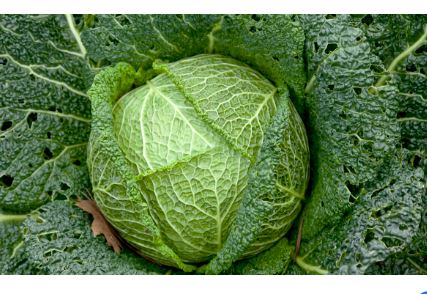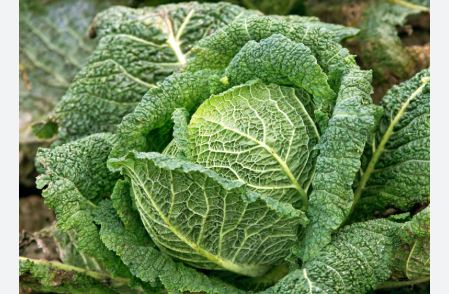
Botanical Classification
Savoy cabbage, scientifically classified as Brassica oleracea var. capitata f. sabauda, is a member of the Brassicaceae family, which includes cruciferous vegetables like broccoli, kale, and Brussels sprouts. This cultivar is a type of head cabbage, distinguished by its crinkled, loose leaves that form a less compact head compared to green or red cabbage.
It shares its species with other cabbage varieties, all derived from wild cabbage native to coastal Europe, but its unique leaf texture sets it apart within the Brassica oleracea group.
Origin and History
Savoy cabbage likely originated in the Savoy region of the Alps, spanning modern-day France and Italy, with cultivation records dating back to the 16th century. Named after this region, it was prized for its cold hardiness and tender, flavorful leaves, becoming a staple in European cuisines, particularly in Italy, France, and Germany.
Its development involved selective breeding to enhance its crinkled texture and adaptability to cooler climates. Today, savoy cabbage is grown globally, valued for its versatility and aesthetic appeal in both traditional and modern dishes.
Identifying Characteristics

Savoy cabbage is easily recognized by its loose, round heads composed of deeply crinkled, ruffled leaves that range from light to dark green. The leaves are thinner and more flexible than those of green cabbage, with a slightly waxy surface and a delicate, almost lacy appearance.
Heads typically weigh 2–4 pounds and are less dense than other cabbages, giving them a softer, more pliable texture. The inner leaves are pale and tender, while the outer leaves are tougher and more vibrant, adding visual and textural contrast.
Taste
Savoy cabbage has a mild, sweet flavor with a subtle earthy undertone, less pungent than green or red cabbage. Its tender, crinkled leaves offer a crisp yet delicate texture when raw, becoming soft and velvety when cooked.
The sweetness intensifies with cooler growing conditions or light frost, making it a favorite for dishes requiring a gentle cabbage flavor. Its nuanced taste complements both bold and delicate ingredients, enhancing a wide range of culinary preparations.
Seasons/Availability
Savoy cabbage is a cool-season crop, typically available from late summer through early winter (August–January) in the Northern Hemisphere, with peak harvests in fall when cooler temperatures enhance flavor and texture.
It thrives in mild climates and can tolerate light frost, which improves sweetness. Year-round availability is possible in some regions due to storage and greenhouse cultivation, and it is commonly found in supermarkets, farmers’ markets, and specialty grocers during its peak season.
Culinary Uses
Savoy cabbage’s tender, pliable leaves make it highly versatile in the kitchen. Raw, it adds texture and color to salads or slaws, though its softer leaves are less crunchy than green cabbage. It excels in cooked dishes like stir-fries, soups, stews, and braises, where its delicate texture absorbs flavors from ingredients like butter, cream, or garlic.
In European cuisines, it’s often used in stuffed cabbage rolls, Italian minestrone, or German dishes with bacon or sausage. Its flexible leaves also make it ideal for wrapping fillings, and it can be lightly steamed or sautéed as a side dish.
Nutritional Value
Savoy cabbage is a low-calorie, nutrient-rich vegetable, providing about 25–30 calories per cup. It is an excellent source of vitamin C, an antioxidant that supports immune health, and vitamin K, crucial for blood clotting and bone health. It also offers dietary fiber for digestion, folate for cell function, and small amounts of manganese, vitamin B6, and potassium.
As a cruciferous vegetable, it contains glucosinolates, compounds associated with potential cancer-fighting properties, and antioxidants that reduce inflammation. Its high water content adds hydration, making it a wholesome dietary choice.
Cultivation of Savoy Cabbage
- Climate Requirements: Savoy cabbage thrives in cool, temperate climates with temperatures between 45°F and 75°F (7°C–24°C). It is highly frost-tolerant, enduring light frosts down to 20°F (-6°C), which enhance its sweetness by converting starches to sugars. Prolonged heat above 80°F (27°C) can cause loose heads or bolting, making it ideal for spring or fall planting in most U.S. regions, targeting late summer to early winter harvests (August–January).
- Soil Preferences: This cabbage prefers fertile, well-drained loamy soil with a pH of 6.0–7.5. Incorporate organic matter, such as compost or well-rotted manure, to enrich soil fertility and improve moisture retention. Good drainage prevents root rot, and a neutral pH ensures nutrient availability, supporting the development of its characteristic crinkled leaves and loose heads.
- Planting Time: In the U.S., sow savoy cabbage seeds in early spring (February–March) for a late spring to early summer harvest, or in late summer (July–August) for a fall to early winter harvest. Start seeds indoors 6–8 weeks before the last frost or sow directly when soil temperatures are 50°F–70°F (10°C–21°C). Transplants should be set out when seedlings are 4–6 inches tall.
- Seed Selection: Choose high-quality seeds of savoy cabbage varieties like ‘Savoy King’, ‘Savoy Ace’, or ‘Perfection’ for disease resistance, vibrant crinkled leaves, and uniform heads. Select varieties suited to your region’s climate and growing season. Fresh seeds from reputable suppliers ensure high germination rates, as older seeds may have reduced viability, affecting crop establishment.
- Spacing and Planting: Space plants 18–24 inches apart in rows 24–36 inches apart to accommodate the loose, round heads and ensure good air circulation. Plant seedlings at the same depth as their nursery pots, firming soil around roots to stabilize plants. Proper spacing promotes healthy leaf development and reduces disease risk by allowing adequate light and airflow.
- Watering Needs: Provide consistent moisture, delivering 1–1.5 inches of water per week, adjusted for rainfall. Savoy cabbage requires even watering to prevent head splitting and maintain tender, crinkled leaves. Avoid waterlogging, which can cause root issues, and use drip irrigation or soaker hoses to keep soil moist while minimizing leaf wetness, reducing fungal disease risks.
- Fertilization: Savoy cabbage is a moderate feeder, requiring a balanced fertilizer (e.g., 10-10-10) at planting to support early growth. Side-dress with a nitrogen-rich fertilizer, such as blood meal or fish emulsion, 3–6 weeks after transplanting and again when heads begin forming. Avoid over-fertilizing late in the season to prevent excessive leaf growth at the expense of head development.
- Pest Management: Monitor for pests like cabbage worms, aphids, and slugs, which can damage crinkled leaves. Use floating row covers to protect young plants from egg-laying insects, hand-pick caterpillars, or apply organic controls like neem oil or Bt (Bacillus thuringiensis). Companion planting with herbs like dill or encouraging beneficial insects like ladybugs can naturally control aphid populations.
- Disease Control: Savoy cabbage is susceptible to fungal diseases such as clubroot, black rot, and downy mildew, particularly in wet or poorly drained soils. Practice crop rotation every 3–4 years, maintain soil pH above 6.0, and ensure good drainage to minimize disease risk. Remove infected plant debris and select disease-resistant varieties, using organic fungicides only if necessary.
- Weed Control: Keep the growing area free of weeds, which compete for nutrients, water, and light. Hand-weed or hoe regularly, especially during early growth stages. Apply organic mulch, such as straw or wood chips, to suppress weeds, retain soil moisture, and regulate temperature, supporting healthy root systems and vibrant leaf texture.
- Support and Pruning: Savoy cabbage forms loose heads and typically doesn’t require staking, but hilling soil around the base can stabilize plants in windy conditions. Remove yellowing or damaged outer leaves to improve air circulation and reduce pest and disease habitats. Minimal pruning is needed, but trimming lower leaves can enhance head appearance and direct energy to head formation.
- Harvesting: Harvest savoy cabbage when heads are firm yet slightly loose, typically weighing 2–4 pounds, about 70–100 days after transplanting, depending on the variety. Cut heads at the base with a sharp knife, leaving a few outer leaves for potential regrowth in mild climates. Harvesting after a light frost enhances sweetness, but avoid delays to prevent splitting or toughening.
- Post-Harvest Care: Store savoy cabbage in a cool, humid environment (32°F–40°F, 0°C–4°C) with 90–95% humidity for up to 2–3 months. Wrap heads in plastic or store in perforated bags to maintain freshness and prevent wilting. For continuous harvests, stagger plantings every 2–3 weeks during the planting season to ensure a steady supply of tender, crinkled heads.